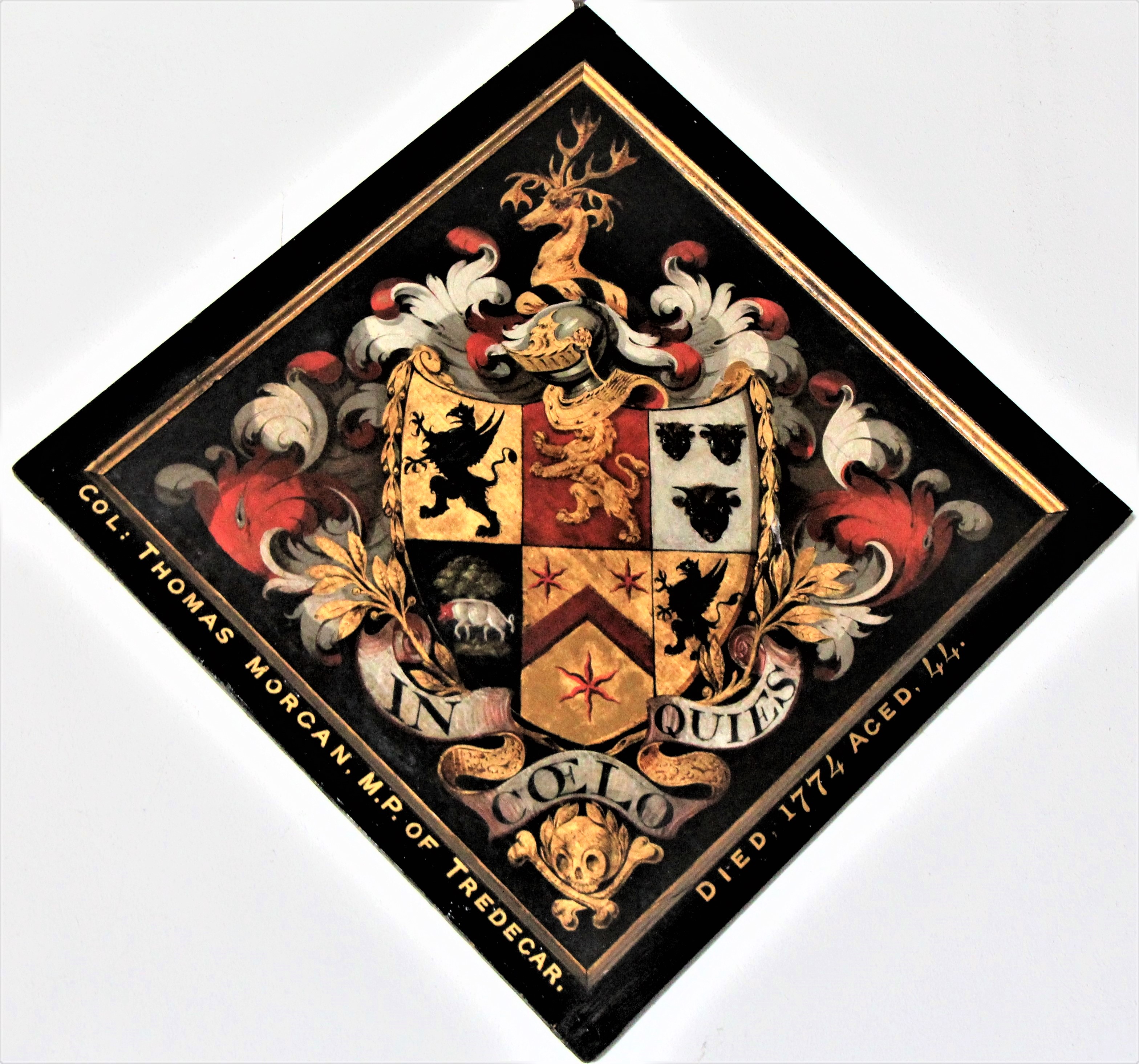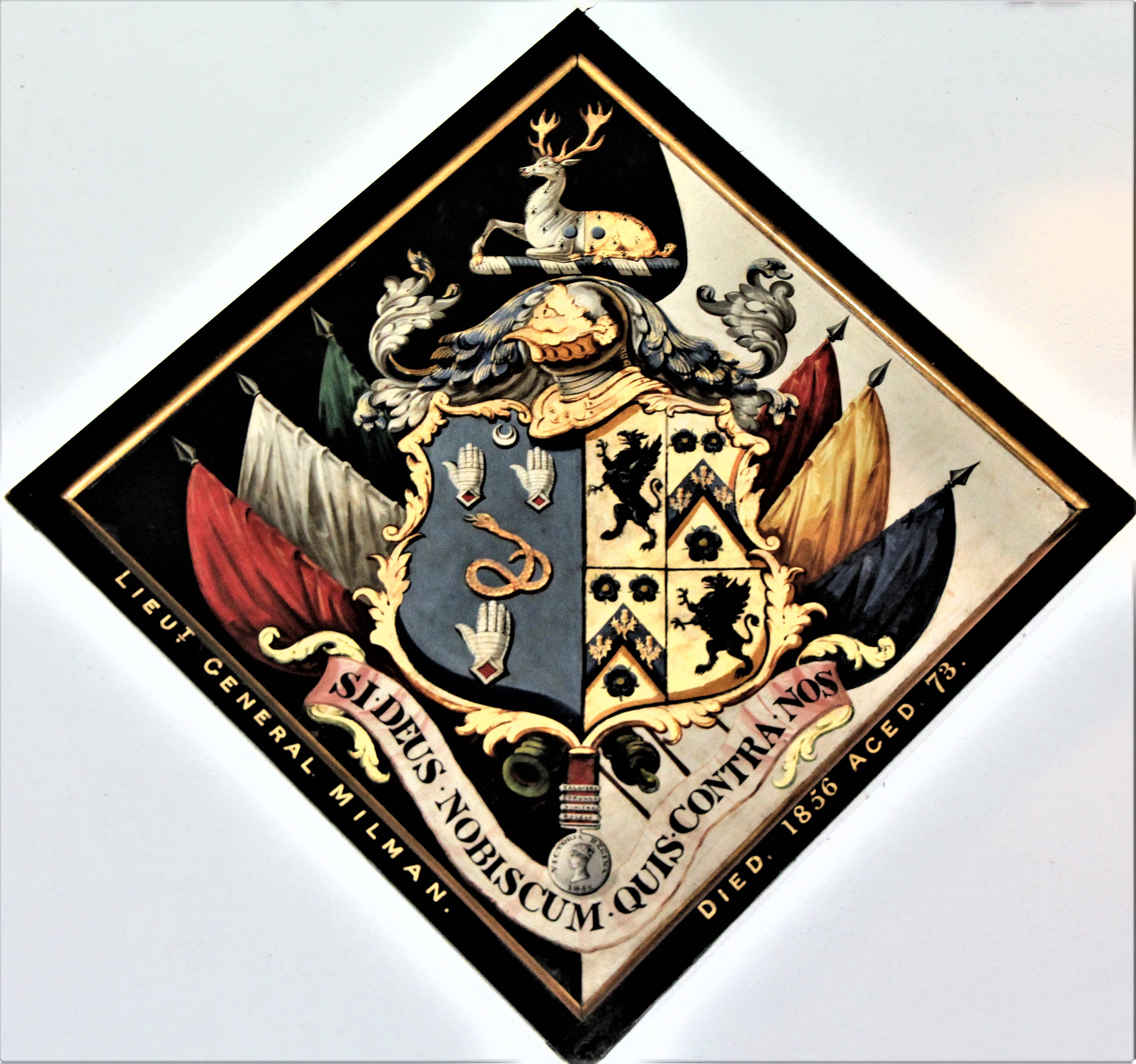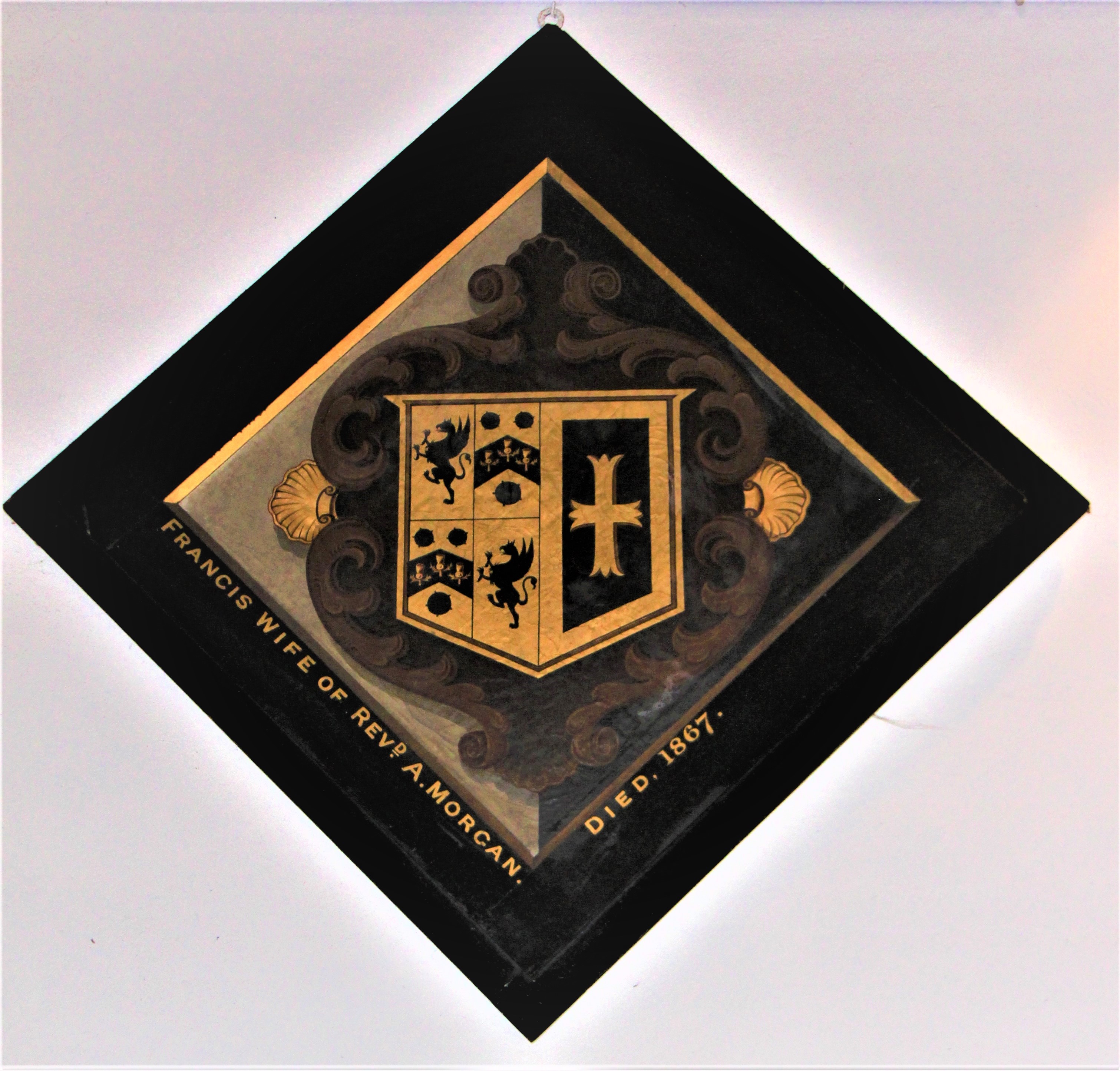An Introduction to Hatchments
Funerary Hatchments were used in Britain from the 17th century. By the 20th century, however, their use was much reduced and now are only used for royalty or the noblest of families. Originally theywere known as an “achievement” from the French word “achèvement”. They would have been displayed outside a deceased person’s home soon after their death and then used in the funeral cortege. As a lasting memorial, hatchments would then be placed in the parish church where the deceased was buried or at a church that was closely associated with the family.
The Lower Machen hatchments each comprise a large diamond-shaped coat of arms up to 2 metres tall, painted on canvas over a timber frame. The design, colour, and decoration of hatchments follow the rules of Medieval heraldry, where it was usual to carry a deceased knight’s heraldic shield before his coffin. A hatchment for a man comprises a shield (escutcheon) bearing heraldic arms, with a helmet (helm) above, on which sits the crest (a decorative sculpture such as a stag’s head) worn by knights in tournaments. The base of the crest is usually encircled with twisted cloth (a torse) while the shield is supported against a background of heraldic imagery. The images on a hatchment for a lady may have a cherub replacing the helm and crest while retaining the shield.

The Lower Machen Hatchments
Some churches, as is the case in Lower Machen, display numerous hatchments associated with a local gentry family. The eleven hatchments at St Michael & All Angels are the largest collection in any church in Wales and Monmouthshire. All are dedicated to members or relatives of the Morgan family of Tredegar. Tredegar here refers to the old mansion of Tredegar Fawr, an agricultural estate, (now the site of the nearby Tredegar House), which the Morgans occupied from 1402. The name should not be confused with the much more recent industrial town of Tredegar about 20 miles north of Newport, which was named in honour of the Tredegar Estate.
Above the pulpit is the hatchment for Jane Morgan, died 1767, who was the wife of Thomas Morgan MP, and is the oldest in the church. The most recent hatchment is for the Revd Augustus Morgan (d.1875) who was the Rector of Machen for 42 years. Seven hatchments are from the 18th century and relate to six members of the family all of whom are buried in the Morgan Chapel (two hatchments are for John Morgan d.1787). Of the four 19th century hatchments, Revd Augustus Morgan and his wife Frances are buried at St Basil’s Church, Bassaleg. Anna Lascelles, Frances’ older sister and Miles Milman, husband of Maria Margaretta Morgan are buried in London.
The quality of hatchment workmanship can vary considerably depending on the skills and education of local artists and craftsmen who made them. It is not uncommon for some details to be incorrect (as is evident with the Charles Morgan hatchment on the west wall where his name is spelt incorrectly). The hatchments were expertly renovated by Frederick Ernest Secombe, father of the Revd Fred Secombe (Rector of Machen from 1954 to 1959). Further conservation works were carried out in the late 1980s. Two of the hatchments appeared in the BBC’s Antiques Roadshow broadcast on 23rd November 2014.
If you would like to find out more about the Hatchments then visit our “Remarkable Books” page where you can order our books!.
How to read the Morgan Hatchments
Everything on a hatchment has a very specific meaning for the deceased person’s family. Hatchments are a sombre celebration of not only the achievements of the deceased but also the achievements of much earlier generations. 1-3
Medieval heraldic terms, outlined below, are used to describe the symbols and imagery on hatchments. There are very specific rules that apply to the design, colour and decoration.

The Crest is a decorative sculpture on top of a knight’s helmet (Helm) draped in a cloth, called Mantling.
A Torse is a twisted roll of fabric laid between the helmet and crest, hiding the join and fixing the mantling in place. Sometimes the helm and crest would be replaced with another device, for instance, a cherub on a lady’s hatchment.
The Frame includes an Inscription giving brief details of the deceased.
Black denotes the male line so a black Background would be used for a bachelor. White denotes the maternal line so a black and white background depicts that the deceased was a married man or woman.
The right half of the hatchment as it faces you, called the Dexter side, is for the deceased person; the left is the Sinister side for the surviving spouse. Dexter originates from the Latin “a dextra”: on the right and Sinister is from the Latin “ad sinistram”: on the left.
An Escutcheon is a shield, displaying one or more Arms which are heraldic devices granted to individuals that allowed them to bear “arms” (weapons). Once received, arms pass through the children’s line. A Coat of Arms (or more properly the escutcheon) often comprises many arms due to the combination of different family lines over the generations. The combining of arms on the shield is called Quartering even though the number of arms can greatly exceed four.
A single coat of arms denotes an unmarried man. Where the deceased was married, the spouse’s arms would also appear. Where a wife is not an heiress and survives her husband her paternal arms are “Impaled” (set alongside her husband’s) to denote union. Where the wife is an heiress or co-heir her family arms are displayed over the husband’s; this is called “In Pretence” (and refers to the husband “pretending” to represent the family of his wife).
A family Motto was often included on a hatchment, but it was frequently replaced by a Latin phrase relating to death and resurrection such as “In Coelo Quies” (Resting in Heaven) which appears on four of the St Michael’s hatchments.
A Death’s Head, or human skull at the base of the hatchment usually, but not always, symbolises that the deceased died childless. Other symbolic decorations could be used to denote status or military achievement etc., such as a peer’s robe or regimental colours and honours placed around the arms.
The Hatchments
To see and find out more about the Hatchments in St Michael and All Angels, click on their names below








